
Never ending stretches of backwaters and lush green coconut groves welcome you as you drive through the southern Indian state of Kerala. It is the only state in India where the sex ratio is of 1084 females per 1000 males. At 92%, Kerala has one of the highest female literacy rates in the country. And yet, years of gender-oriented division of labour has resulted in the concentration of women in low-paying unorganised sectors such as agricultural labour, cottage industries and selected service sectors. This is a reality for women across the country. Due to lack of access or opportunities in organised sectors, most women earn their livelihood from agriculture labour, dairy and dairy-related sectors, fishing or by running a small business of a grocery shop, an eatery, a laundry or a salon.
If we observe closely, the women entrepreneurs who run a variety of local small businesses are drivers of the local economy in many ways. Women also dominate the agriculture and dairy labour in the country. In fact, they make a significant contribution to the Indian economy. There are nearly three million micro, small, and medium enterprises with full or partial female ownership in the country as of today. Collectively, these women-owned businesses employ over 8 million people. This information makes us ask some pertinent questions: “Who are these women entrepreneurs?” and “How do they run their enterprises?”“How are women coping with the challenges of earning a livelihood?” and “How is the economic contribution of women being recognised in the nation’s GDP?”
In 2014, for two months I drove across the country covering 18,181 km, in search of answers to these questions. What I saw and came to accept is that women everywhere, from Kashmir to Kanyakumari and Gujarat to Guwahati, are busy. They are busy working, making, selling, buying and driving the local economies of their communities, villages and towns. Where business is not possible, they have managed to organise themselves into Self Help Groups (SHGs) and are building their own ecosystems of survival and success. They are not lured by government schemes and in many cases are primary breadwinners of their families. Many are living alone either because of age or due to migration of the male members of their family. Those engaged in agriculture labour are espousing for manufacturing jobs as secondary jobs to earn additional income, those running small shops are training older daughters and sons to run a second shop, and those working from home and making handloom products are selling to tourists from the furthest corners of the world. They don’t seem to need any subsidies or special care. These women are proud workers and are acutely aware of their contribution to the economic well-being of their families and communities. But what they do need is a robust ecosystem to fuel their growth further.
One striking example of this woman power is Reddy Amma. She is above 60 years of age, runs a small Naidu cuisine eatery in downtown Tirupati, Andhra Pradesh, and only employs men. You ask her why, and she promptly says that her kind of food is eaten by drivers, labourers and workers who only get free late in the evenings and women would not stay so late to cook or serve. She sits in front of her eatery with self-pride and confidence. She has not heard of the government’s special programmes for women and elderly. She couldn’t care what they are, she is firmly established in a business she started when her husband died 22 years ago. Her only wish is to have enough cash to open another eatery next door. And Reddy Amma is not alone in her aspirations.
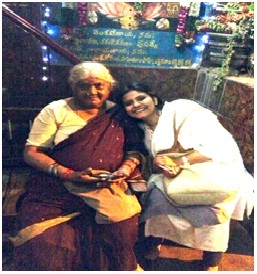
With Reddy Amma outside her eatery
Guntur in Andhra Pradesh is credited with growing 25% of the world’s chilli. It is the women of Guntur who work in the farms under 40 degrees centigrade heat and cultivate the chilli. They have formed successful SHGs to sell their produce collectively in the local markets. But they are not satisfied. They would like manufacturing jobs as second jobs; they would also like a loan to set up their own chilli powder plant. Their questions to me were not about how they can get help from the local panchayat or register for MGNREGA jobs. Their questions were about how their SHG can get a loan for starting a food-processing unit? This makes one wonder: Who is listening to these women and how can we empower their aspirations?
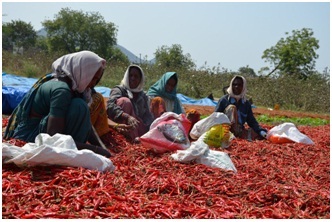
Chilli farmers of Guntur
The marginalisation of women in the economic process and lack of control over resources have been major impediments in improving the status of women. But women in India’s tribal belts and India’s northeast states have surpassed these obstacles by adopting the role of the retail sellers and marketers themselves. A drive through the local market day in a Gond tribal area in the jungles of the Eastern Ghats in Odisha can open your eyes to who is the primary seller of fruits, vegetables, grains and even fertilisers. It’s the Gond women; they travel together from their small tribal hamlets and bring their produce to sell on the market day, sometimes travelling even 50 km by road.
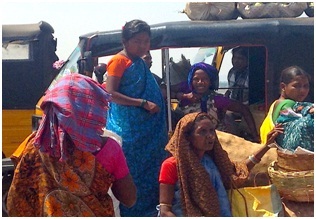
Gond tribal women on the market day
Women in the state of Manipur run entire markets. All major markets in Imphal for household groceries and items are run by women, in fact no man can sell in these markets. Women in these markets are proud of their status in society and work together to protect each other. In Mizoram, it is only women you will see selling everything from watermelons to fish to bees and snails. The question here is what have we done to empower the efforts of these women towards self-reliance? And how are we recognising their contribution to the nation’s GDP?
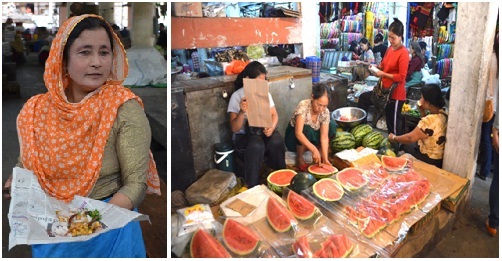
Left – A woman seller in the all-woman market in Imphal, Manipur; Right – Women sellers in Aizwal, Mizoram
If not through enterprise women are working towards keeping their own livelihood in their own hands, quite literally. In the poorest of poor villages in West Bengal, the Santhal women have formed SHGs to meet their own livelihood needs. In the temple town of Mandi in Himachal Pradesh, women are offering the services of a Priestess.Krishna Devi poojaran in the Bhoothnath temple in Mandi didn’t shy away from taking up the job of a priestess to make ends meet.
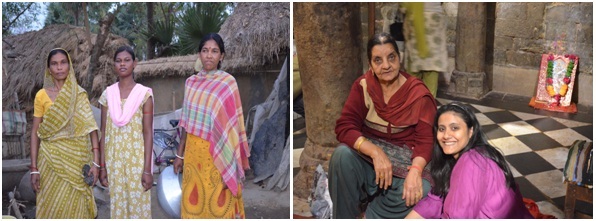
Left – Santhal women of Bowticholi, West Bengal; Right – With Krishna Devi Poojaran, Mandi, Himachal Pradesh
Women in Rajasthan walk for hours to reach the local markets to sell their handlooms and dyed fabrics to western tourists. And there is no sign of the hardship on their faces, one is always greeted with a huge smile, so typical of a sales person. Whereas young girls in Hampi in Karnataka have learnt to speak conversational English and drive electric golf carts to support pollution-free tourism at the major temples of this UNESCO world heritage site.
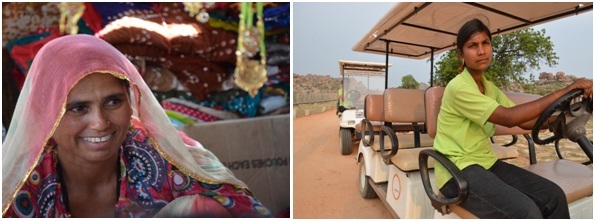
Left – Rajasthani handloom woman seller; Right – Women electric cart operators, Hampi, Karnataka
All these examples give us the basis to question the state’s role in empowering more and more women to actively participate in the nation’s economic progress and not be passive recipients to state disbursed benefits. If women can achieve so much in the absence of an ecosystem how much they will achieve if a conducive environment was provided to them? From public safety, transport, sanitation to even equality of wages, there are many issues that need to be examined and resolved to give fuel to the committed women of the nation who wake up every morning with a firm resolve to stand on their feet and earn from their hard work. Amul, SEWA, Lijjat are a few success stories that come to our mind but the state’s role and recognition is still limited in them. The example that stands out for the state’s active role in shaping a robust ecosystem for women is that of the Kudumbashree initiative of the Government of Kerala.
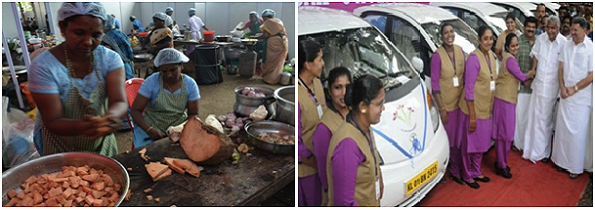
Left – A pickle-making unit under Kudumbashree, Kerala; Right – Launch of the Kudumbashree travel company in Thiruvananthapuram
Kudumbashree is the largest women's movement in Asia with a membership of 4.1 million women. It was started in 1998 by the Kerala government to create opportunities for women in both local governance and economy and was launched by the then Prime Minster Atal Bihari Vajpayee. Today, almost 17 years later, the movement has community-based organisations (CBOs) consisting of 2.59 lakh Neighbourhood Groups (NHG), 19,773 Area Development Societies (ADSs) and 1,072 Community Development Societies (CDSs) in both urban and rural areas of Kerala. These grassroots bodies have mobilised a sum of Rs 2075 crore as thrift and disbursed loans amounting to Rs 8540 crore to the members of the Neighbourhood Groups. Under the aegis of the Kudumbashree programme 25,000 individual enterprises and 1750 group enterprises of women have been developed in the urban areas of the state. Similarly, 3500 individual enterprises and 10600 group enterprises of women have been formed in the rural areas. Through its network of CBOs, Kudumbashree has given support to almost 2 lakh women cultivators and 50000 women groups for collective farming in the state.
By its sustained and committed efforts in the state of Kerala, Kudumbashree has empowered the women to contribute in an organised and recognised manner to the nation’s accounting. Many issues facing women workers, business owners and entrepreneurs can be resolved if we figure out a holistic approach to strengthening and recognising women’s contribution to the nation’s GDP. Kerala could not have ridden the success wave of its “God’s Own Country” campaign if it weren’t for its investment in an initiative such as Kudumbashree. Why should other states not follow this example? It is evident from the Kudumbashree example that in the recognition of the power of women-led economic contribution to the nation’s GDP, we can truly realise and unleash the potential of India’s Stree Shakti.
The author is Chairperson, IEF and Executive Director, SCA Group.